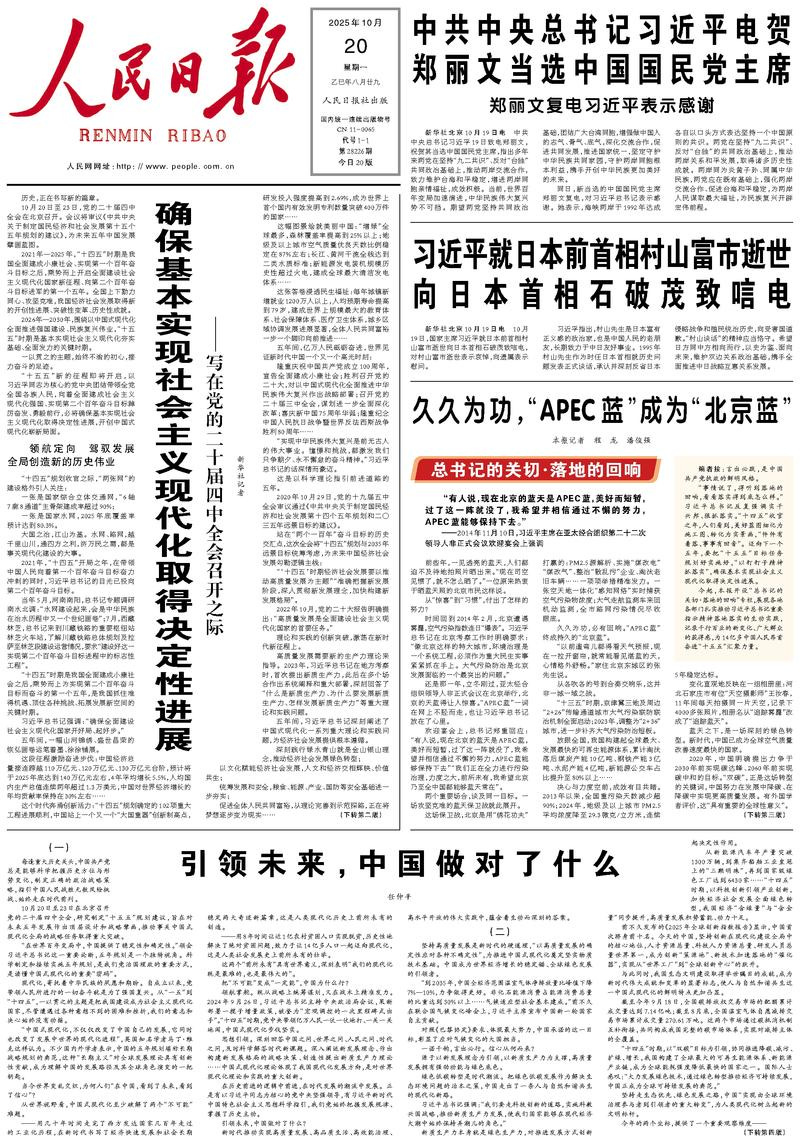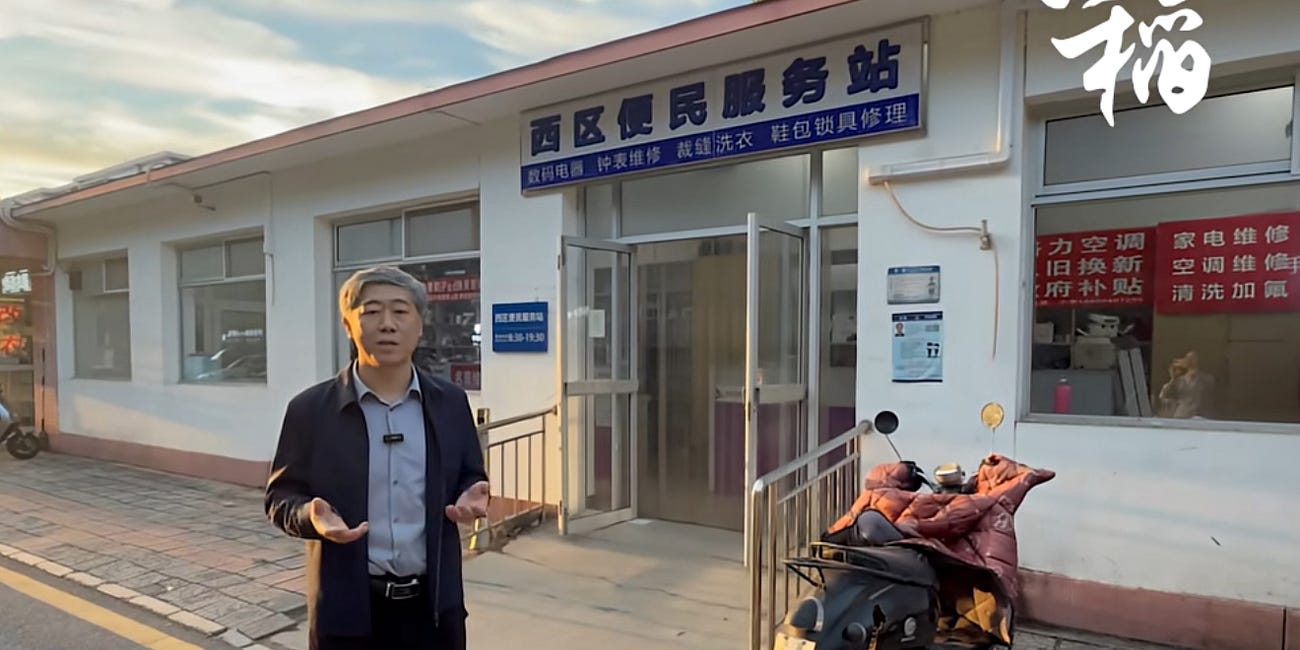Xinhua Signals Three Themes for China’s 15th Five-Year Plan
Domestic markets-unifying measures billed as economic reforms, "new productive forces” in innovation and manufacturing, and people-centered welfare.
Xinhua, the state news agency, overnight published 确保基本实现社会主义现代化取得决定性进展——写在党的二十届四中全会召开之际 Ensure that decisive progress is made toward the basic realization of socialist modernization — Written on the occasion of the convening of the Fourth Plenary Session of the 20th CPC Central Committee, which was printed as the No.1 news on today’s front page of People’s Daily.
Given that the title rests on Written on the occasion of the convening of the Fourth Plenary Session of the 20th CPC Central Committee, it’s clearly square at the Oct 20-23 meeting.
Now, the meeting’s agenda includes more than one thing, but the Xinhua article focuses just on the 15th Five-Year Plan (2026-2030)
From October 20 to 23, the Fourth Plenary Session of the 20th Central Committee of the Communist Party of China will be held in Beijing. The meeting will review and deliberate on the Proposals of the CPC Central Committee for Formulating the 15th Five-Year Plan for National Economic and Social Development, charting the blueprint for China’s development over the next five years.
The last one-third of the article, translated in full below, offers a few broad but telling hints about the main themes of the forthcoming proposals for the 15th Five-Year Plan. Admittedly, the messages remain vague. Yet given the dearth of public information on the 15th FYP and the enormous appetite for clues, even three faintly discernible directions are worth noting.
First, Measures aimed at recalibrating the relationship between government and market—such as trimming excessive regulation and reducing market fragmentation—which Beijing describes as economic reforms.
Second, innovation in science and education, alongside upgraded manufacturing, is captured in the official term new quality productive forces. This signals a stronger focus on technology-driven industrial upgrading, from advanced chips and AI to robotics and clean energy vehicles, with education, talent, and research integrated into a single national strategy.
Third, improving public services through greater “investment in people” is portrayed as the next phase of common prosperity.
The full translation of the last one-third of the article
What kind of five years will the “15th Five-Year Plan” be—amid the great historical journey of the rejuvenation of the Chinese nation and the accelerating transformation of the world unseen in a century?
A New Five Years: The Road of Reform Will Widen Further
On July 18, 2024, the Third Plenary Session of the 20th CPC Central Committee reviewed and adopted The Decision of the CPC Central Committee on Further Comprehensively Deepening Reform and Advancing Chinese Modernization. The bugle call to further deepen reform in the new era and on the new journey has resounded across China.
The Decision states that “by the 80th anniversary of the founding of the People’s Republic of China in 2029, all reform tasks set forth in this Decision will be completed.” More than 300 reform measures are to be fully implemented during the “15th Five-Year Plan” period, continuously strengthening the driving force and vitality of Chinese modernization.
Chinese modernization has been continuously advanced through reform and opening up—and it will surely open up an even broader future through further reform and opening up.
On July 1, 2025, General Secretary Xi Jinping chaired the sixth meeting of the Central Financial and Economic Affairs Commission, where he proposed the basic requirements of “Five Unifications and One Openness” for promoting the construction of a unified national market in greater depth:
Unifying fundamental market institutions,
Unifying market infrastructure,
Unifying the standards of government conduct,
Unifying market regulation and enforcement,
Unifying factor and resource markets,
while continuously expanding openness domestically and internationally.
Each requirement aims to better handle the relationship between government and market, to spur deeper reforms, and to continuously cultivate and unleash the advantages and potential of China’s ultra-large-scale market—providing a solid foundation for navigating changes and opening new frontiers on the new journey.
“Practice has proven that medium- and long-term development planning can both give full play to the decisive role of the market in resource allocation and better bring into play the role of the government.” General Secretary Xi Jinping has attached great importance to the role of Five-Year Plans in better managing the relationship between government and market.
Through the formulation and implementation of the “15th Five-Year Plan,” China will better leverage the roles of both an efficient market and a proactive government—using the market to enhance resource allocation efficiency, and the government to remedy market failures.
A New Five Years: The Force of Innovation Will Be Unstoppable
Accurately grasping the new stage of development, thoroughly implementing the new development philosophy, accelerating the creation of a new development pattern, and focusing on promoting high-quality development—these define the main thread shaping China’s economic and social development in all aspects.
On July 7 this year, General Secretary Xi Jinping visited Yangquan Valve Co., Ltd. in Shanxi Province.
In the production workshop, he paused frequently to observe and inquire in detail about production and sales, emphasizing: “We must never abandon the real economy. Within the real economy, traditional industries cannot be abandoned either—they must be transformed and upgraded through scientific and technological innovation.”
By placing the development of new quality productive forces “in an even more prominent strategic position,” Xi underscored the profound thinking of a leader in the new era on high-quality development—his precise grasp of development trends and global currents.
Over the past five years, China has achieved breakthroughs: domestically developed high-performance chips and operating systems; AI large models empowering thousands of industries; robots significantly enhancing productivity; annual production of new energy vehicles surpassing 10 million units; and world-leading advances in drones, high-speed rail, and quantum technology.
“With science and technology innovation as the guide and the real economy as the foundation,” “aiming at the global technological frontier, continuing to strengthen basic research and original innovation, accelerating breakthroughs in key core and frontier technologies,” and “coordinating the integrated development of education, science and technology, and talent”—
these are the foundations of China’s next leap.
Facing the “15th Five-Year Plan,” China will take regionally adapted development of new quality productive forces as a key lever to drive industrial upgrading and institutional reform, injecting powerful momentum into high-quality development.
A New Five Years: The Foundation of People’s Livelihood Will Be Further Strengthened
Starting January 1, 2025, China will provide childcare subsidies for infants under three years old who are born in compliance with laws and regulations. The subsidy will be distributed annually until the child reaches the age of three.
This marks the first large-scale, universal, and direct cash benefit for people’s livelihood since the founding of the People’s Republic—reflecting a deep-seated commitment to “investing in people” and embodying the value principle of “people first.”
The new chapter of development is written in the abundance of the land and the prosperity of ordinary households.
Five years ago, a key Party document for the first time set forth the major goal of “common prosperity for all.” In the “14th Five-Year Plan,” over one-third of major indicators concerned people’s livelihood and well-being.
How can China effectively fill gaps in public services? How can urgent livelihood concerns be addressed in practice? How can common prosperity be steadily advanced?
In shaping the “15th Five-Year Plan,” the fruits of modernization will be shared more extensively and more equitably by all the people.
A New Five Years: The Foundation of Confidence Will Grow Ever Stronger
As the great changes unseen in a century accelerate, the magnitude of both opportunities and challenges is unprecedented. China will unswervingly focus on managing its own affairs well and on expanding high-level opening up; take multiple measures to stabilize employment, enterprises, markets, and expectations, thereby keeping the economic fundamentals stable; and place greater emphasis on balancing development and security, ensuring the new development pattern through a new security framework.
China’s economy remains stable, with abundant advantages, strong resilience, and vast potential. The fundamental conditions supporting long-term growth remain unchanged. The institutional advantages of socialism with Chinese characteristics, the advantages of an ultra-large domestic market, a complete industrial system, and abundant human resources are becoming even more evident.
Chinese modernization has clear goals, plans, and strategies—and it will certainly be achieved.
The journey ahead is vast, and the blueprint ever more magnificent.
Under the strong leadership of the CPC Central Committee with Comrade Xi Jinping at its core, hundreds of millions of Chinese people—imbued with an unprecedented spirit of historical initiative and creativity—will unite with one heart and one mind, forging ahead to write an even more splendid chapter of Chinese modernization.
China may materially raise pensions for rural residents in the next five years, David Daokui Li and Song Xuetao say
The 20th Central Committee of the Communist Party of China will convene its Fourth Plenum in Beijing from October 20 to 23, which will produce a recommendation for the 15th Five-Year Plan (FYP) for Economic and Social Development (2026-2030), slated for adoption by the National People’s Congress in early March 2026.




